Ch7-Global compensation, benefits, and taxes2
北师大版必修三unit7作文
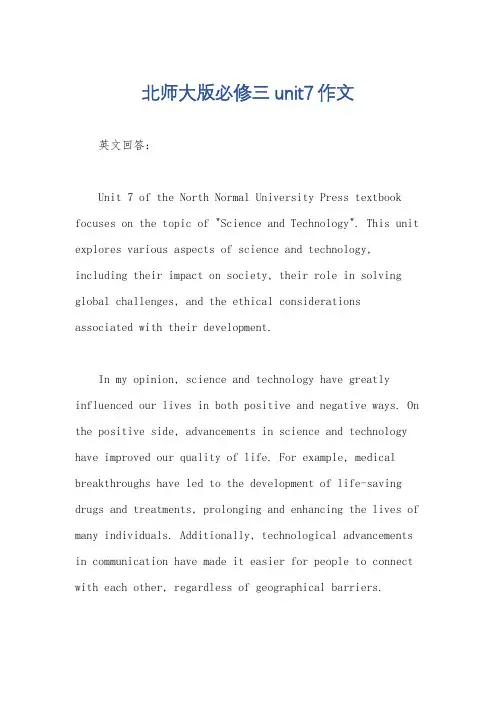
北师大版必修三unit7作文英文回答:Unit 7 of the North Normal University Press textbook focuses on the topic of "Science and Technology". This unit explores various aspects of science and technology, including their impact on society, their role in solving global challenges, and the ethical considerations associated with their development.In my opinion, science and technology have greatly influenced our lives in both positive and negative ways. On the positive side, advancements in science and technology have improved our quality of life. For example, medical breakthroughs have led to the development of life-saving drugs and treatments, prolonging and enhancing the lives of many individuals. Additionally, technological advancements in communication have made it easier for people to connect with each other, regardless of geographical barriers.However, there are also negative consequences associated with science and technology. One major concernis the environmental impact. For instance, the excessive use of fossil fuels in industrial processes has contributed to global warming and climate change. Moreover, the overreliance on technology has led to a sedentary lifestyle for many individuals, resulting in health problems such as obesity and cardiovascular diseases.中文回答:北师大版必修三第七单元的主题是“科学与技术”。
教育的作用 英语作文
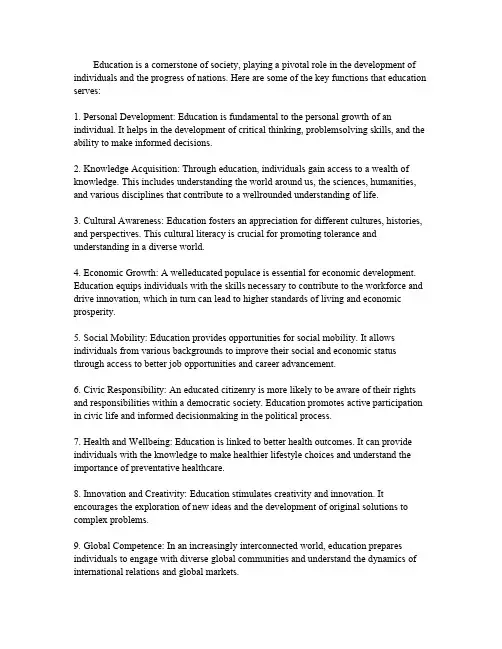
Education is a cornerstone of society,playing a pivotal role in the development of individuals and the progress of nations.Here are some of the key functions that education serves:1.Personal Development:Education is fundamental to the personal growth of an individual.It helps in the development of critical thinking,problemsolving skills,and the ability to make informed decisions.2.Knowledge Acquisition:Through education,individuals gain access to a wealth of knowledge.This includes understanding the world around us,the sciences,humanities, and various disciplines that contribute to a wellrounded understanding of life.3.Cultural Awareness:Education fosters an appreciation for different cultures,histories, and perspectives.This cultural literacy is crucial for promoting tolerance and understanding in a diverse world.4.Economic Growth:A welleducated populace is essential for economic development. Education equips individuals with the skills necessary to contribute to the workforce and drive innovation,which in turn can lead to higher standards of living and economic prosperity.5.Social Mobility:Education provides opportunities for social mobility.It allows individuals from various backgrounds to improve their social and economic status through access to better job opportunities and career advancement.6.Civic Responsibility:An educated citizenry is more likely to be aware of their rights and responsibilities within a democratic cation promotes active participation in civic life and informed decisionmaking in the political process.7.Health and Wellbeing:Education is linked to better health outcomes.It can provide individuals with the knowledge to make healthier lifestyle choices and understand the importance of preventative healthcare.8.Innovation and Creativity:Education stimulates creativity and innovation.It encourages the exploration of new ideas and the development of original solutions to complex problems.9.Global Competence:In an increasingly interconnected world,education prepares individuals to engage with diverse global communities and understand the dynamics of international relations and global markets.10.Lifelong Learning:Education instills a love for learning that extends beyond formal schooling.It encourages a mindset of continuous selfimprovement and adaptation to a rapidly changing world.In conclusion,the role of education is multifaceted and indispensable.It is not only about academic achievement but also about nurturing wellrounded individuals who can contribute positively to society and the world at large.。
和国际的科技接轨英语作文
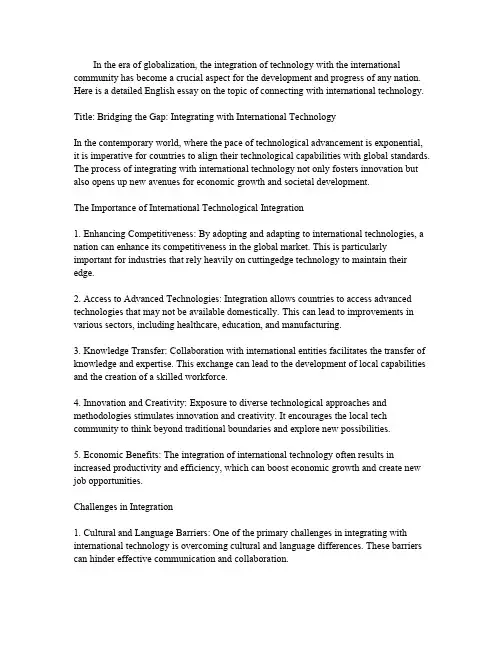
In the era of globalization,the integration of technology with the international community has become a crucial aspect for the development and progress of any nation. Here is a detailed English essay on the topic of connecting with international technology.Title:Bridging the Gap:Integrating with International TechnologyIn the contemporary world,where the pace of technological advancement is exponential, it is imperative for countries to align their technological capabilities with global standards. The process of integrating with international technology not only fosters innovation but also opens up new avenues for economic growth and societal development.The Importance of International Technological Integration1.Enhancing Competitiveness:By adopting and adapting to international technologies,a nation can enhance its competitiveness in the global market.This is particularly important for industries that rely heavily on cuttingedge technology to maintain their edge.2.Access to Advanced Technologies:Integration allows countries to access advanced technologies that may not be available domestically.This can lead to improvements in various sectors,including healthcare,education,and manufacturing.3.Knowledge Transfer:Collaboration with international entities facilitates the transfer of knowledge and expertise.This exchange can lead to the development of local capabilities and the creation of a skilled workforce.4.Innovation and Creativity:Exposure to diverse technological approaches and methodologies stimulates innovation and creativity.It encourages the local tech community to think beyond traditional boundaries and explore new possibilities.5.Economic Benefits:The integration of international technology often results in increased productivity and efficiency,which can boost economic growth and create new job opportunities.Challenges in Integration1.Cultural and Language Barriers:One of the primary challenges in integrating with international technology is overcoming cultural and language differences.These barriers can hinder effective communication and collaboration.2.Intellectual Property Rights:Navigating the complex landscape of intellectual property rights can be a significant hurdle.It is essential to respect and adhere to international laws and agreements to avoid disputes.3.Technological Infrastructure:Developing the necessary infrastructure to support advanced technologies can be a considerable challenge,especially for developing countries with limited resources.4.Security Concerns:With the integration of international technology comes the risk of cyber threats and data breaches.It is crucial to implement robust security measures to protect sensitive information.Strategies for Successful Integration1.Policy and Regulatory Frameworks:Governments should establish clear policies and regulatory frameworks that encourage and facilitate the integration of international technology.2.Investment in Research and Development:A strong focus on research and development can help in creating indigenous technologies that can compete on the global stage.cation and Training:Investing in education and training programs can equip the workforce with the necessary skills to adapt to and work with international technologies.4.PublicPrivate Partnerships:Collaborative efforts between the public and private sectors can lead to the development of innovative solutions and the sharing of resources.5.International Collaboration:Engaging in international partnerships and alliances can provide access to new technologies and markets,fostering a global network of technological exchange.ConclusionThe integration of international technology is a multifaceted process that requires strategic planning,investment,and a commitment to overcoming challenges.By embracing this integration,nations can not only enhance their technological capabilities but also contribute to the global technological ecosystem,fostering a more interconnected and advanced world.。
高效人士的七个原则读后感英文
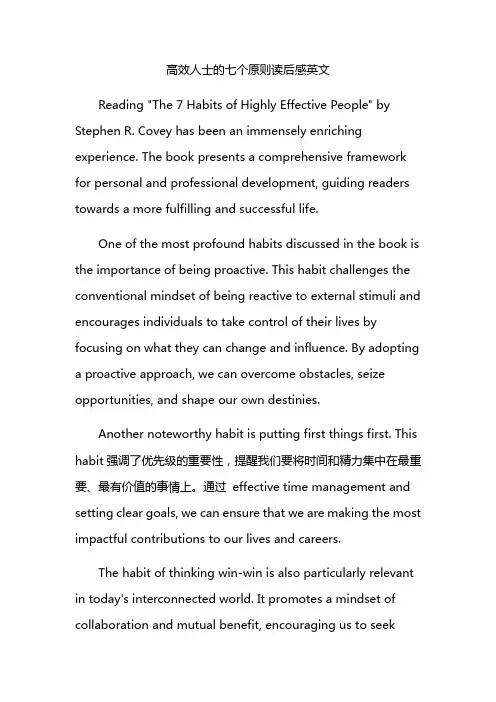
高效人士的七个原则读后感英文Reading "The 7 Habits of Highly Effective People" by Stephen R. Covey has been an immensely enriching experience. The book presents a comprehensive framework for personal and professional development, guiding readers towards a more fulfilling and successful life.One of the most profound habits discussed in the book is the importance of being proactive. This habit challenges the conventional mindset of being reactive to external stimuli and encourages individuals to take control of their lives by focusing on what they can change and influence. By adopting a proactive approach, we can overcome obstacles, seize opportunities, and shape our own destinies.Another noteworthy habit is putting first things first. This habit强调了优先级的重要性,提醒我们要将时间和精力集中在最重要、最有价值的事情上。
通过effective time management and setting clear goals, we can ensure that we are making the most impactful contributions to our lives and careers.The habit of thinking win-win is also particularly relevant in today's interconnected world. It promotes a mindset of collaboration and mutual benefit, encouraging us to seeksolutions that benefit all parties involved. By adopting this habit, we can foster stronger relationships, build trust, and achieve greater success together.Furthermore, the book emphasizes the importance of seeking first to understand, then to be understood. This habit challenges us to listen actively and empathize with others before expressing our own opinions. By doing so, we can establish deeper connections, resolve conflicts effectively, and create a more harmonious environment.The remaining habits - synergy, sharpening the saw, and finding your voice - further complement the framework, providing practical tools and strategies for personal growth and leadership development.In conclusion, "The 7 Habits of Highly Effective People" is a must-read for anyone seeking to enhance their personal and professional lives. The habits presented in the book are timeless principles that can be applied to various situations and challenges. By incorporating these habits into our daily lives, we can become more effective, fulfilled, and successful individuals.。
大学思辨英语教材精读1unit7
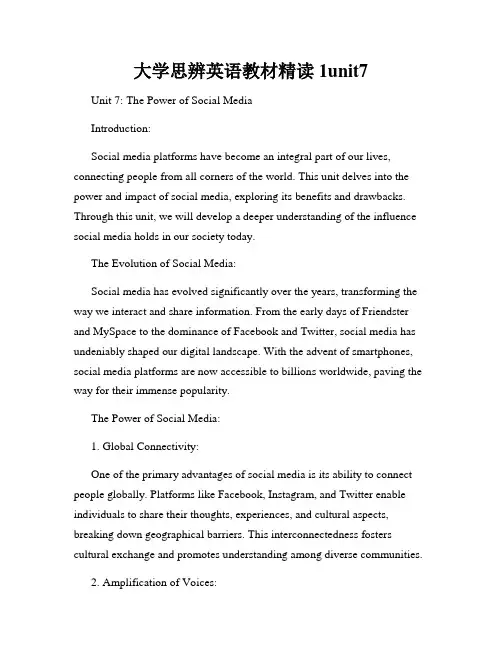
大学思辨英语教材精读1unit7Unit 7: The Power of Social MediaIntroduction:Social media platforms have become an integral part of our lives, connecting people from all corners of the world. This unit delves into the power and impact of social media, exploring its benefits and drawbacks. Through this unit, we will develop a deeper understanding of the influence social media holds in our society today.The Evolution of Social Media:Social media has evolved significantly over the years, transforming the way we interact and share information. From the early days of Friendster and MySpace to the dominance of Facebook and Twitter, social media has undeniably shaped our digital landscape. With the advent of smartphones, social media platforms are now accessible to billions worldwide, paving the way for their immense popularity.The Power of Social Media:1. Global Connectivity:One of the primary advantages of social media is its ability to connect people globally. Platforms like Facebook, Instagram, and Twitter enable individuals to share their thoughts, experiences, and cultural aspects, breaking down geographical barriers. This interconnectedness fosters cultural exchange and promotes understanding among diverse communities.2. Amplification of Voices:In the era of social media, everyone has the opportunity to have their voices heard. Previously, traditional media held the sole power to disseminate information. However, social media allows ordinary individuals to share their opinions and raise awareness about various issues. It has given a voice to marginalized communities, shining a light on social injustices.3. Marketing and Branding:Social media has revolutionized the way businesses advertise and build their brands. Platforms like Instagram and YouTube serve as powerful marketing tools, enabling companies to reach a broader audience and engage directly with potential customers. Influencer marketing has emerged as a popular trend, as brands collaborate with social media personalities to endorse their products or services.4. Real-Time Information:Social media networks provide instant access to breaking news and real-time updates. During times of crisis or emergencies, platforms like Twitter serve as essential sources of information. Social media has also played a pivotal role in organizing social movements and protests, allowing individuals to mobilize and unite for a common cause.Drawbacks of Social Media:1. Privacy Concerns:With the influx of personal information shared on social media platforms, there are heightened concerns regarding privacy. Despite stringent privacy settings, instances of data breaches and unauthorized access persist, raising questions about the security of our personal information.2. Cyberbullying and Harassment:The anonymity provided by social media has allowed for the rise of cyberbullying and online harassment. Individuals can hide behind screens and target others, causing significant emotional distress. Social media platforms are continuously battling this issue by implementing measures to prevent and address cyberbullying incidents.3. Spread of Misinformation:The rapid dissemination of information on social media can lead to the spread of misinformation and fake news. With the absence of fact-checking and editorial control, false narratives and conspiracy theories can easily circulate, fueling confusion and mistrust.4. Addiction and Mental Health Issues:Excessive use of social media has been linked to addiction and various mental health problems, including anxiety and depression. The constant need for social validation, comparison, and the fear of missing out (FOMO) can negatively impact one's well-being.Conclusion:Social media has become an indispensable part of our daily lives, reshaping how we connect, communicate, and consume information. While it offers numerous advantages such as global connectivity and amplification of voices, we must also acknowledge its drawbacks, including privacy concerns and the spread of misinformation. As users of social media, it is crucial to exercise caution and critical thinking to fully harness its potential while mitigating its negative impact.。
技术在消除贫困和不平等中的作用英语作文
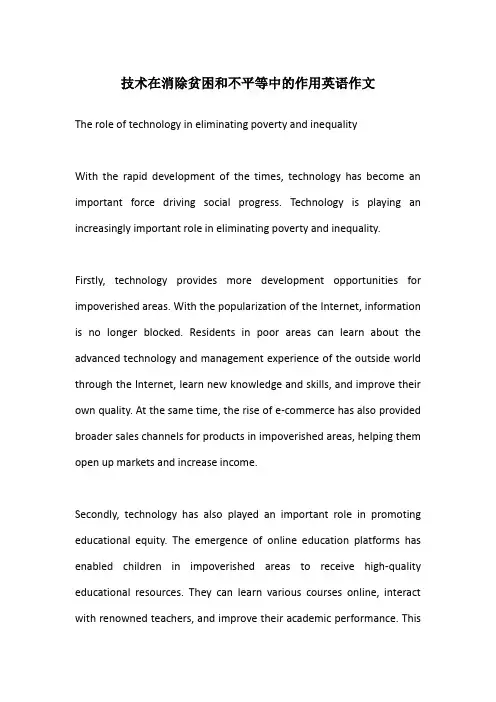
技术在消除贫困和不平等中的作用英语作文The role of technology in eliminating poverty and inequalityWith the rapid development of the times, technology has become an important force driving social progress. Technology is playing an increasingly important role in eliminating poverty and inequality.Firstly, technology provides more development opportunities for impoverished areas. With the popularization of the Internet, information is no longer blocked. Residents in poor areas can learn about the advanced technology and management experience of the outside world through the Internet, learn new knowledge and skills, and improve their own quality. At the same time, the rise of e-commerce has also provided broader sales channels for products in impoverished areas, helping them open up markets and increase income.Secondly, technology has also played an important role in promoting educational equity. The emergence of online education platforms has enabled children in impoverished areas to receive high-quality educational resources. They can learn various courses online, interact with renowned teachers, and improve their academic performance. Thisnot only contributes to their personal growth, but also lays a solid foundation for their future career development.In addition, the application of technology in the medical field has also contributed to eliminating poverty and inequality. The development of remote medical technology has enabled residents in impoverished areas to enjoy high-quality medical services. They can communicate with distant doctors through video consultations, online consultations, and other means to obtain professional medical advice and treatment plans. This not only improves the efficiency of medical services, but also reduces the medical costs in impoverished areas.However, technology also faces some challenges in eliminating poverty and inequality. For example, the imbalance in technological development may lead to the emergence of new inequalities. Therefore, in the process of promoting and applying technology, we need to pay attention to fairness and inclusiveness, ensuring that everyone can enjoy the benefits brought by technology.In short, technology plays an important role in eliminating poverty and inequality. We should fully utilize the advantages of technology to provide more assistance and support to impoverished areas andvulnerable groups, and promote comprehensive social progress and development.技术在消除贫困和不平等中的作用随着时代的快速发展,技术已成为推动社会进步的重要力量。
4 - International Comp and Benefits
Overview
Global Remuneration
A well designed global Compensation and Benefits system will balance the cost and benefits for the company and yet make the total reward system attractive for the recruitment and retention of employees.
Compensation and Benefits for International Assignments
The purpose of developing an international assignment policy is to ensure greater consistency and equity among international assignees and reduce barriers to global mobility.
Most Expensive Cities in the World, 2007
Rank (most expensive) 1 2 3 4 5 6 7 8 9 10 EIU survey Oslo Paris Copenhagen London Tokyo Reykjavik Zurich Osaka Frankfurt Helsinki Mercer survey Moscow Seoul Tokyo Hong Kong London Osaka Geneva Copenhagen Zurich Oslo USB survey London New York Oslo Tokyo Zurich Copenhagen Geneva Dublin Chicago Los Angeles
促进全球眼科学的交流与合作的英语作文
促进全球眼科学的交流与合作的英语作文Global Collaboration and Exchange in OphthalmologyThe field of ophthalmology has been witnessing remarkable advancements in recent years driven by the relentless efforts of healthcare professionals, researchers, and innovative technology. As the world becomes increasingly interconnected, the need for global collaboration and exchange in the realm of eye care has become more crucial than ever before. Promoting international cooperation and knowledge-sharing can lead to groundbreaking discoveries, improved patient outcomes, and a more equitable access to quality eye health services worldwide.One of the primary benefits of global collaboration in ophthalmology is the ability to pool together diverse expertise and resources. By fostering partnerships between clinicians, researchers, and institutions across different countries, the field can leverage a wider range of perspectives, skills, and technological capabilities. This collaborative approach can accelerate the development and implementation of innovative diagnostic tools, treatment modalities, and preventive strategies, ultimately enhancing the overall quality of eye care.Moreover, international exchange of knowledge and best practices can help address the disparities in eye health that exist across various regions. Through shared learning and the dissemination of evidence-based practices, healthcare professionals can gain valuable insights into effective approaches to managing diverse eye conditions, tailored to the unique cultural and socioeconomic contexts of different populations. This exchange of knowledge can lead to the adoption of more efficient and culturally-appropriate eye care solutions, ensuring that quality eye health services are accessible to individuals regardless of their geographic location or socioeconomic status.In addition to the clinical and research-oriented benefits, global collaboration in ophthalmology can also contribute to the professional development of healthcare providers. By facilitating cross-cultural exchanges, clinicians and researchers can broaden their understanding of diverse medical practices, expand their clinical expertise, and gain exposure to innovative approaches to eye care. This exchange of knowledge and experiences can ultimately enhance the quality of patient care and drive the continuous improvement of ophthalmological practices worldwide.Furthermore, international cooperation in ophthalmology can foster the development of standardized protocols, guidelines, and qualityassurance measures. Through the collaborative efforts of global organizations and professional associations, the field can establish consistent standards of care, ensuring that patients receive high-quality and evidence-based eye health services regardless of their location. This harmonization of practices can also facilitate the seamless exchange of medical data, enabling more robust epidemiological studies and the identification of global trends and patterns in eye health.One prominent example of successful global collaboration in ophthalmology is the World Health Organization's (WHO) "VISION 2020: The Right to Sight" initiative. Launched in 1999, this global program aims to eliminate avoidable blindness by the year 2020 through the coordinated efforts of national governments, non-governmental organizations, and international partners. By fostering collaborative networks, sharing best practices, and mobilizing resources, the VISION 2020 initiative has made significant strides in addressing the leading causes of visual impairment and blindness, such as cataract, refractive errors, and trachoma, in various regions of the world.Another exemplary initiative is the International Council of Ophthalmology (ICO), a global organization dedicated to enhancing eye care worldwide. The ICO facilitates international collaboration through various programs, including the development ofstandardized ophthalmic education curricula, the organization of international conferences and workshops, and the promotion of research collaborations. These collaborative efforts have contributed to the advancement of ophthalmological practices, the dissemination of knowledge, and the strengthening of the global eye health community.In conclusion, promoting global collaboration and exchange in the field of ophthalmology is crucial for addressing the pressing challenges and disparities in eye care worldwide. By fostering international partnerships, sharing knowledge and best practices, and leveraging diverse expertise and resources, the ophthalmological community can drive innovations, improve patient outcomes, and ensure equitable access to quality eye health services globally. Through continued commitment to collaborative efforts, the field of ophthalmology can continue to evolve and make a lasting impact on the well-being of individuals and communities around the world.。
Compensation and Benefits
Compensation and BenefitsEmployees work for compensation, the money or benefits or both for which an employee exchange work.A business compensation system has three main purposes:Attracting qualified employees;Retaining those employeesMotivating higher levels of performance from themA firm achieves each of these goals through the various aspects of the compensation system.A compensation system includesbase pay (the basic wages or salaries that workers receive)incentives (bonus and other plans designed to encourage employees to produce work beyond the minimum acceptable levels)benefits (services that employees receive that are paid for by the employer, like health insurance, pension, vacations)a good system motivates effective performanceby establishing fair individual rates of compensationby effectively linking performance to compensationToday’s Human Resources ChallengesAt no other time in history has business faced to so many and such complex human resources challenges as it does today.It worths summarizing them:1.How to establish and maintain equal employment opportunities for women and minoritygroup members2.How to cope with the increasingly complex legal requirements related to employeecompensation and benefit plan3.What to do about the skyrocketing costs of health care, which directly affect the cost ofmedical insurance4.How to set up equitable rates of pay to reflect female and male employees’ comparable worthto the firm5.What businesses can use to motivate employees when labor market conditions dictate thatentry-level salaries must nearly match those being paid to senior employees in the same job classification6.How to motivate new hires in two-ties system who will never achieve the base pay of senioremployees in the same job7.Seek out solutions to curb on-the-job use of alcohol plaguing entry-level employees8.How to balance the employee’s right to privacy with the employer’s right to know in the areaof drag and AIDS testing9.How to deal with AIDS and fear of AIDS in the workplace。
雅思剑7第二篇作文
雅思剑7第二篇作文Title: The Impact of Technology on Human RelationshipsIn the modern era, technology has become an integral part of our lives. It has transformed the way we communicate, work, and interact with each other. While technology has undoubtedly brought about numerous benefits, it has also raised concerns about its impact on human relationships. This essay will explore the positive and negative effects of technology on human relationships, and discuss the need for a balanced approach to technology use.The first positive effect of technology on human relationships is the ease of communication. With the advent of smartphones, social media, and instant messaging apps, people can now stay connected with their friends and family members, regardless of the distance between them. This has made it easier for people to maintain long-distance relationships and keep in touch with their loved ones. Moreover, technology has also facilitated the formation of new relationships, as people can now meet and interact with others from different parts of the world through online platforms.Another positive effect of technology on human relationships is the access to information and resources. The internet has become a treasure trove of knowledge, and people can now learn about different cultures, traditions, and perspectives through online forums, blogs, and social media. This has broadened people's horizons and fostered a greater understanding and appreciation of diversity. Furthermore, technology has also enabled people to collaborate and work together on projects, regardless of their physical location. This has facilitated the development of global communities and networks, and has brought people closer together.However, despite these benefits, technology has also had some negative effects on human relationships. One of the main concerns is the decline in face-to-face interactions. As people become more reliant on technology for communication, theytend to spend less time engaging in face-to-face conversations. This can lead to a lack of emotional connection and intimacy in relationships, as non-verbal cues and body language play a crucial role in conveying emotions and building trust. Moreover, the overuse of technology can also lead to feelings of isolation and loneliness, as people may become more focused on their devices than on their relationships with others.Another negative effect of technology on human relationships is the potential for miscommunication and misunderstanding. With the reliance on text-based communication, it can be difficult to convey tone and intent accurately. This can lead to misinterpretations and conflicts in relationships. Furthermore, the use of social media can also create unrealistic expectations and pressures, as people may compare their lives to the curated images and stories shared by others online. This can lead to feelings of inadequacy and dissatisfaction, and can strain relationships.In conclusion, technology has both positive and negative effects on human relationships. While it has made communication easier and facilitated the formation of new relationships, it has also led to a decline in face-to-face interactions and the potential for miscommunication. To mitigate these negative effects, it is important for individuals to strike a balance between technology use and real-life interactions. This can be achieved by setting boundaries and allocating time for face-to-face conversations and activities. By doing so, we can ensure that technology enhances, rather than detracts from, our relationships with others.In writing this essay, I have drawn on my own experiences and observations, as well as research and studies conducted in the field of technology and human relationships. I believe that a balanced approach to technology use is essential for maintaining healthy and fulfilling relationships in the modern world.。
- 1、下载文档前请自行甄别文档内容的完整性,平台不提供额外的编辑、内容补充、找答案等附加服务。
- 2、"仅部分预览"的文档,不可在线预览部分如存在完整性等问题,可反馈申请退款(可完整预览的文档不适用该条件!)。
- 3、如文档侵犯您的权益,请联系客服反馈,我们会尽快为您处理(人工客服工作时间:9:00-18:30)。
Optional Benefits- Non-essential compensation to be made available if it is a competitive practice in the local marketplace
Firms should offer something from each core category of benefit to every employee worldwide.
Introduction
Global Remuneration :
A well designed global Compensation and Benefits system will balance the cost and benefits for the company and make the total reward system attractive for the recruitment and retention of employees.
CH7 Global compensation, benefits, and taxes
Lline the basic objectives of global
compensation and benefits (C&B)
• Distinguish between global remuneration and international assignment C&B • Identify critical issue in C&B of the global work force of the MNE
Insurance
Leave
• Most countries have laws regarding special leave, such as maternal and paternal leave or sick leave.
Flexible Benefits
• Flex benefits have been successful in the US, so other countries are beginning to try it as well. • Firms need to attract and retain more diversified work forces. Flex benefits are a way to attract workers with diverse benefit needs. • Foreign firms are investing in American health care companies and have realized how important flex benefits are in the US for controlling rising health care costs.
Tax Laws
• Have the biggest impact on how firms structure their C&B systems.
Global Law of Economics
• Work needs to be located where the quality and cost of the production of goods and services are optimized.
Host Location Costs Shared Between Employee & Firm
Housing Housing Income Taxes
Housing Goods and Services Discretionary Income
Discretionary Income
Balance Sheet
• Consider adjustment (differential) to make up for differences in home and host country living • Additional incentives and premiums to motivate the employee to take on the assignment
Global Benefits in Practice
Core Benefits- Basic item that the company commits to make available to all employees worldwide (i.e. healthcare) Required Benefits- Compensation item or non-cash benefit required by local law Recommended Benefits- Less essential compensation or benefit program to be made available where cost considerations permit
Approaches to Compensation
Negotiation
Balance Sheet
Lump Sum Global System
Cafeteria
Regional System
Negotiation
• Used when there are few international assignees • Not recommended as each negotiation becomes the baseline for the next assignee
Hourly Compensation for Production Workers in Manufacturing, 2004
Country
Australia Brazil France Germany
Index (U.S.=100)
101 13 149 142
Hourly $
23.09 3.03 23.89 32.53
Home-Country Equivalent Purchasing Power
Premiums and Incentives
Income Taxes Housing Goods and Services Discretionary Income Goods and Services Goods and Services Discretionary Income
• There has been a decline in working hours per year around the world.
• Wide variances among countries in holiday and vacation requirements. • Some countries have defined benefit and/or contribution plans, while others have government social security systems. • Some Asian countries have no retirement plans at all. • Many policies may not transfer overseas, so special coverage is usually required for international assignees.
Global Remuneration Issues and Challenges
Culture
• Influences how people perceive the value of various rewards.
Salary-benefit ratio
• Amount of compensation that is salary versus benefits differs by country.
此一方法之目的是使派外人員在國外擁有與在母國時相同之購買力(purchasing power);並且再提供另外之激勵津貼(incentive and premium)。
HomeCountry Salary
Home- and AssignmentLocation Income Taxes Income Taxes
Japan
Mexico United Kingdom United States Norway
96
11 108 100 151
21.9
2.5 24.71 22.87 34.64
Global Benefits
Working Hours Holiday and Vacation Benefits Pension Plans
Main Objectives for a Global Compensation and Benefits Program
Attraction and retention of the best qualified talent. Attraction and retention of employees who are qualified for international assignments. Facilitation of transfers between various employment locations. Equity between compensation of employees at home and abroad. Compensation that is equitable in relation to the practices of competitors, yet minimizes costs to the extent possible.
